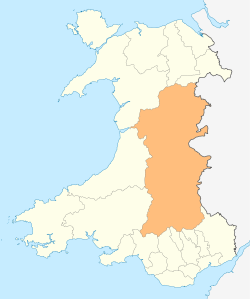Capel-y-ffin
| Capel-y-ffin | |
 Capel-y-ffin |
|
| Population | 50 (estimated) |
|---|---|
| Principal area | Powys |
| Ceremonial county | Powys |
| Country | Wales |
| Sovereign state | United Kingdom |
| Post town | ABERGAVENNY |
| Postcode district | NP7 |
| Dialling code | 01873 |
| Police | Dyfed-Powys |
| Fire | Mid and West Wales |
| Ambulance | Welsh |
| EU Parliament | Wales |
| UK Parliament | Brecon & Radnorshire |
Coordinates: 51°59′02″N 3°05′24″W / 51.984°N 3.090°W
Capel-y-ffin is a hamlet near the English-Welsh border, a couple of miles north of Llanthony in Powys, Wales. It lies within in the Black Mountains[1] within the Brecon Beacons National Park. The nearest town is Hay-on-Wye, some 8 miles (13 km) to the north-west.
History
The Chapel

Capel-y-ffin means "chapel of the boundary", since it lies in the valley of the River Honddu close to the borders with Monmouthshire in Wales and Herefordshire in England, as well as the borders of the Anglican dioceses of Hereford, St David's, and Llandaff. The chapel itself is dedicated to St Mary and was built in 1762, replacing an earlier 15th century structure. It originally served as a chapel of ease for the parish church at Llanigon, but is now within its own ecclesiastical parish. With an interior of just 26 by 13 feet (8 by 4 metres), the chapel is one of the smallest in Wales[2] and reminded diarist Francis Kilvert of an owl.
On the other side of the River Honddu is a small, whitewashed Baptist chapel built by the two brothers, William and David Prosser. A wall plaque commemorates their work in bringing The Ministry of the Gospel to their house in the year 1737. And Secured this Place for That Sacred Use for the Time Being. Both died near the End of the Year 1780.[3]
The hamlet was the last Welsh-speaking community in this part of Wales.[4]
The Monastery

In 1869, Joseph Leycester Lyne, self-styled "Father Ignatius", purchased 32 acres (130,000 m2) of land at Capel-y-ffin in order to build an Anglican monastery near the ruins of Llanthony Priory. With the help of fellow monks and local masons, he succeeded in building 'Llanthony Tertia', where an eccentric version of monastic life – witnessed by Francis Kilvert – continued till his death in 1908. Lyne is buried in the monastery church which, being poorly built and subsequently neglected, is now partly ruined.[5][6] A memorial trust exists to restore the church and an annual pilgrimage is held between Llanthony Priory and Capel-y-ffin.[7]
In 1880, Lyne's religious convictions were confirmed by visions of the Virgin Mary seen in the monastery and nearby fields by monks and local farm boys.[8] The Vision Farm, to the south-east of the hamlet, was so renamed as a result of these apparitions. The farm (at least in name) features in the novel On the Black Hill by Bruce Chatwin, though the author changed its location.
From August 1924 to October 1928, artist Eric Gill and his followers lived in some notoriety in the former monastery at Capel-y-ffin. It was here that he designed the typefaces Perpetua and Gill Sans. With him was poet and artist David Jones, who painted the local scenery.[9] Jones features as a character in the novel Resistance by Owen Sheers, set close by in the Olchon Valley.
Notes
- ↑
- ↑ "Archived copy". Archived from the original on 2008-07-06. Retrieved 2009-07-16.
- ↑ Keen, Richard and Burgum, Ian Wales, Orion Publishing Group (1997), pg. 129.
- ↑ E.G. Ravenstein, Celtic Languages of the British Isles, 1878
- ↑ "Archived copy". Archived from the original on 2010-03-02. Retrieved 2009-07-16.
- ↑ http://www.geograph.org.uk/photo/649004 photo of monastery
- ↑ http://www.fatherignatius.com/index.phtml
- ↑ "Archived copy". Archived from the original on 2010-03-02. Retrieved 2009-07-16.
- ↑ J. Miles, Eric Gill & David Jones at Capel-y-ffin,1992 ISBN 1-85411-051-9
External links
- ["A spiritual journey (The Guardian, May 2006)" https://www.theguardian.com/travel/2006/may/03/unitedkingdom.onlocationfilminspiredtravel.culturaltrips]
